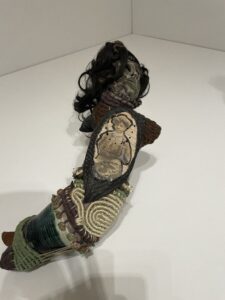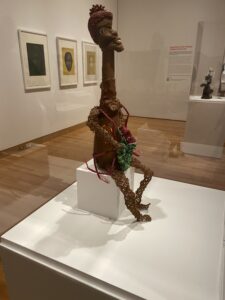Seattle Art Museum, 1300 First Avenue, Seattle, 98101 Runs until January 19, 2025.

“I want to be amazed when I’m working. I want to confound myself. I want to tell a new story each time. I want to see the poetry in it. I want to see the labor in it. It is a kind of sacred embrace. That’s the part you use to create. That’s the part that others may not know or see.”

Joyce Scott is not afraid to be in your face. It has helped in her expressive journey that she learned about the peyote stitch in 1976 from Native American artist Sandy Fife Wilson. The peyote stitch is created off a loom allowing much more freedom for the artist than simply attaching her chosen medium, beads, to a flat surface. We see it used throughout the works in the exhibition.
Let us start where the exhibition begins with her sense of connectivity through generations of her family in art making. We first see a large construction made of fabric, with quilts on the walls outside. Inside beaded “quilts” hang on the walls of a “living room” setting complete with a comfortable sofa, sculpture, books, and art works from many cultures.


Scott titles this work The Threads That Unite My Seat to Knowledge, 2024. It brings together quilts by her mother (Elizabeth Talford Scott (Fifty Year Quilt, 1930–80); maternal grandmother, Mary Jane Caldwell; maternal grandfather, Samuel Caldwell; and godmother, Lucille Foster Brown. Inside is a quilt by her paternal grandmother.
This connection across generations is accompanied by sculpture in the same gallery that suggest three powerful images of black womanhood: the birth of a baby, the birth of a dead baby





An early group of works titled Mammie Wadi 1979-1981 (Mother Water) refers to black people who are now in the ocean and have transformed into semi aquatic forms or goddesses. “I’m a water sign. I also have always lived near water. Many religions see underwater as where a lot of the powerful Orishas or gods are. Bones are at the bottom, people who jumped off slave ships or who were thrown off. Ships that went down, planes that drop.”

Look closely at the dresses and many necklaces throughout the exhibition that contain small souvenirs from other cultures, reflecting Scott’s own life experiences.
Each gallery has a theme,
For example there is the Black Nanny series,
The Racist Stereotypes,
Messing with Stereotypes, (in collaboration in one work Donald Byrd of Spectrum Dance ).

Mammy/Penis From the series Still Funny,
2011
Her fearless confrontation with stereotypes like the hypermasculinity of black men is seen in her works like Cuddly Black Dick from 1995-7
In the same section she sends up Aunt Jemima, watermelons and most shockingly, Baby Bait a pair of earrings that refer to a practice celebrated by Southern racists, to feed black baby children to alligators.

On a more cheerful note her delightful Thunder Thigh Review, 1975-1990, flows with her sense of humor and irony. The theme of celebrating the magnificent posteriors of black woman in contrast to the skinny white body was hugely entertaining as well as sending up traditional concepts of beauty.
Scott’s frequently intersects with African sculpture as in Birth of Mammi (Anansi), in which the artist has added complex bead work to an African carving to suggest the birth of Anansi, a spider who is a mythical African trickster.


Note this installation carefully
Lynched Tree, 2011/2024
We see an upside down white person made of beads.
Second image shows rubbish pouring from inside her
Third image is her lower half

Final image is the rest
According to the artist:
A pale-pink beaded figure hangs by her feet, her body open on the ground below. An accumulation of broken glass and discarded things, her insides pour forth from her abdomen and chest cavity. She personifies for Scott “the immature feelings we have as a young, slowly evolving species. The work addresses what we refuse to embrace because, if we accept the truth, then we must change or be proven wrong.”
Other section titles are Making A Way When there is no Way, (sexual and physical violence)

and Ancestor and Progeny.





















Comments